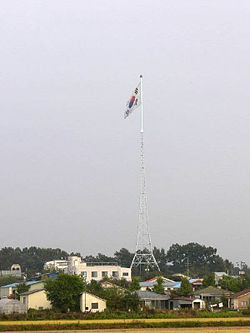Daeseong-dong
Daeseong-dong | |
|---|---|
| Korean transcription(s) | |
| • Hangul | 대성동 |
| • Hanja[1] | 臺城洞 |
| • Revised romanization | Daeseong-dong |
| • McCune–Reischauer | Taesŏng tong |
 | |
| Coordinates: 37°56′28″N 126°40′45″E / 37.941118°N 126.679144°E | |
| Country | South Korea |
| Province | Gyeonggi Province |
| City | Paju |
| Population (2018)[2] | 193 |
Daeseong-dong (also called Tae Sung Dong, Jayu-ui Maeul) is a village in South Korea close to the North Korean border. It lies within the Korean Demilitarized Zone (DMZ). The village is about 1.6 kilometers (1 mile) south of the Bridge of No Return, and 12 km (7.5 miles) from the city of Kaesong, North Korea. As of 2018[update], the village has 193 inhabitants.[2]
Location
Daeseong-dong belongs administratively to Josan-ri, Gunnae-myeon, in Paju. It is the only civilian habitation within the southern portion of the DMZ.[3] Panmunjeom is 1 km (0.6 mi) to the northeast, and the actual Military Demarcation Line (the de facto border between South and North Korea) is only 350 meters (1,150 feet) west of the village. Only individuals who lived in the village before the Korean War, or are descendants of those who did, are allowed to move to the village.[4]
Daeseong-dong is only 1.6 km (1 mi) from Kijong-dong, a village in North Korea's portion of the DMZ. Here Korea's division is starkly apparent: rival national flags can be seen on gigantic flagpoles that have been erected in the two villages.[5]
While the southern half of the DMZ is under the administration of the United Nations Command, the residents of Daesong-dong are considered South Korean civilians, and subject to South Korean laws. These residents have some unique benefits and restrictions. For example, they have the same rights to vote and receive education, but are exempt from national defense duties and taxation. Residents are also allocated large plots of land and have some of the highest farming income in the nation. However, they are subject to limitations. The safety of the villagers is paramount, since North Korean soldiers can cross and have crossed the border.[6] Visitors invited to the village must apply for a military escort two weeks in advance.[7] There is a curfew and headcount at 23:00.[5][4]
Economy

Farming is the primary economic activity of the village, particularly bags of rice sold with a DMZ brand.[4]
Flagpoles
In the 1980s, the South Korean government built a 98.4 m (323 ft) flagpole in Daeseong-dong, which flies a South Korean flag weighing 130 kilograms (287 pounds). In what some have called the "flagpole war", the North Korean government responded by building the 160 m (525 ft) Panmunjeom flagpole in Kijŏng-dong, only 1.2 km (0.7 mi) west of the border with South Korea. It flies a 270 kg (595 lb) flag of North Korea.[8][9]
Elementary school
The village also has a small elementary school, Daeseong-dong Elementary School. The school, once slated for closure due to the changing demographics of the village, now educates a total of thirty children from grades K-6. There is a waiting list to get into the school due to the funding and attention the school receives from the South Korean government.[7] As of 2017, only 10 of the students live in the village.[4]
See also
References
- ^ 각 지방 표정, Munhwa Ilbo, June 13, 2000
- ^ a b 문화체육관광부 국민소통실 (2018-04-05). "DMZ내 하나뿐인 '대성동 자유의 마을' 가보니" (in Korean). 대한민국 정책브리핑. Retrieved 2019-07-26.
- ^ McCurry, Justin (July 21, 2010). "What is the demilitarised zone between North and South Korea?". guardian.co.uk.
- ^ a b c d Rich, Motok (April 20, 2017). "As North Korea Tensions Rise, Farming in the Demilitarized Zone Goes On". The New York Times. Retrieved April 21, 2017.
- ^ a b Onishi, Norimitsu (3 August 2004). "Taesung Village Journal; In a DMZ That Bristles Less, the Villagers Are at Home" – via www.nytimes.com.
- ^ SMITH, DONALD (28 August 1994). "DMZ Not All That Peaceful for S. Korea Village : Asia: North Korean jeeps and other military gear are an unnerving presence for farm families living along the heavily armed border" – via LA Times.
- ^ a b "School in DMZ's 'Freedom Village' becomes coveted learning spot for S. Koreans".
- ^ "CNN.com - Korea's DMZ: 'Scariest place on Earth' - February 20, 2002". 2002-02-20. Retrieved 2007-10-23.
- ^ 개성에 '구멍탄' 5만장 배달했습니다. economy.ohmynews.com (in Korean). Retrieved 2006-12-06.[permanent dead link]
External links
![]() Media related to Daeseong-dong at Wikimedia Commons
Media related to Daeseong-dong at Wikimedia Commons

